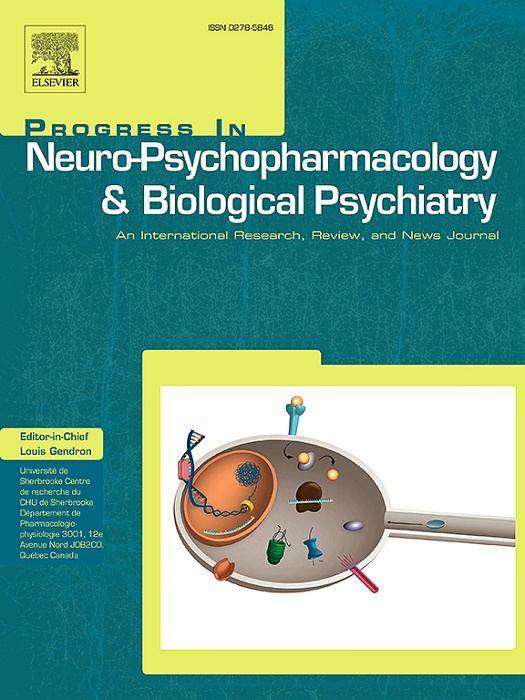Esketamine disinhibits brain networks in depression: Evidence from oscillatory and aperiodic activity
IF 5.3
2区 医学
Q1 CLINICAL NEUROLOGY
Progress in Neuro-Psychopharmacology & Biological Psychiatry
Pub Date : 2025-07-05
DOI:10.1016/j.pnpbp.2025.111438
引用次数: 0
Abstract
Background
Nasal Esketamine is a rapid-acting intervention for depression, hypothesized to exert its effects through cortical disinhibition. However, the spatio-temporal dynamics of brain network activity and their relationship to the subjective drug experience following Esketamine administration remain elusive. This observational study aims to delineate brain network-level effects of Esketamine by analyzing changes in oscillatory and aperiodic EEG activity within 90 min following nasal Esketamine treatment in depression.
Methods
Eight individuals with major depressive disorder undergoing regular Esketamine treatment participated in the study. High-density, eyes-open resting state EEG was recorded before and subsequently five times up to 90 min post-administration. Before each recording, individuals completed ratings of individual drug experience. EEG spectral features were separated into canonical frequency bands and aperiodic exponent. Primary outcomes were changes in neural activity and their association with individual drug experience.
Results
Following Esketamine administration, we observed a marked decrease of frontoparietal alpha power and central beta and a significant increase of frontal midline delta and low gamma power, indicative of cortical disinhibition and reduction of top-down control. Correspondingly, the aperiodic exponent decreased, suggestive of a shift of the excitation/inhibition balance towards excitation. These electrophysiological changes were accompanied by an increase in subjective ratings of highness and happiness, and a decrease in tension. Further analyses revealed significant relationships between changes in neural activity and subjective drug experience.
Conclusion
Our findings suggest that Esketamine induces brain network disinhibition and reduces top-down control. These neurophysiological changes closely correlate with individual drug experience, providing valuable insights into the neural mechanisms underlying Esketamine's immediate behavioral effects.
艾氯胺酮去抑制抑郁症的大脑网络:来自振荡和非周期活动的证据。
背景:鼻用艾氯胺酮是一种治疗抑郁症的速效干预手段,假设其通过皮质去抑制发挥作用。然而,在服用艾氯胺酮后,大脑网络活动的时空动态及其与主观药物体验的关系仍然难以捉摸。本观察性研究旨在通过分析艾氯胺酮鼻腔治疗抑郁症后90 min内振荡和非周期脑电图活动的变化来描述艾氯胺酮的脑网络水平效应。方法:8例重度抑郁症患者接受常规艾氯胺酮治疗。高密度、睁眼静息状态脑电图记录在给药前和给药后6次至90 min。在每次录音之前,每个人都要完成对个人吸毒经历的评分。将EEG频谱特征划分为典型频带和非周期指数。主要结果是神经活动的变化及其与个体药物体验的关系。结果:服用艾氯胺酮后,我们观察到额顶叶α和中央β能量显著下降,额中线δ和低γ能量显著增加,表明皮质去抑制和自上而下控制的减少。相应地,非周期指数下降,表明激发/抑制平衡向激发方向移动。这些电生理变化伴随着主观评价的上升、快乐和紧张程度的降低。进一步的分析揭示了神经活动变化与主观药物体验之间的显著关系。结论:我们的研究结果表明,艾氯胺酮可诱导大脑网络去抑制并降低自上而下的控制。这些神经生理变化与个体用药经验密切相关,为研究艾氯胺酮的直接行为效应背后的神经机制提供了有价值的见解。
本文章由计算机程序翻译,如有差异,请以英文原文为准。
求助全文
约1分钟内获得全文
求助全文
来源期刊
CiteScore
12.00
自引率
1.80%
发文量
153
审稿时长
56 days
期刊介绍:
Progress in Neuro-Psychopharmacology & Biological Psychiatry is an international and multidisciplinary journal which aims to ensure the rapid publication of authoritative reviews and research papers dealing with experimental and clinical aspects of neuro-psychopharmacology and biological psychiatry. Issues of the journal are regularly devoted wholly in or in part to a topical subject.
Progress in Neuro-Psychopharmacology & Biological Psychiatry does not publish work on the actions of biological extracts unless the pharmacological active molecular substrate and/or specific receptor binding properties of the extract compounds are elucidated.

 求助内容:
求助内容: 应助结果提醒方式:
应助结果提醒方式:


